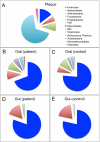Human oral, gut, and plaque microbiota in patients with atherosclerosis
- PMID: 20937873
- PMCID: PMC3063583
- DOI: 10.1073/pnas.1011383107
Human oral, gut, and plaque microbiota in patients with atherosclerosis
Abstract
Periodontal disease has been associated with atherosclerosis, suggesting that bacteria from the oral cavity may contribute to the development of atherosclerosis and cardiovascular disease. Furthermore, the gut microbiota may affect obesity, which is associated with atherosclerosis. Using qPCR, we show that bacterial DNA was present in the atherosclerotic plaque and that the amount of DNA correlated with the amount of leukocytes in the atherosclerotic plaque. To investigate the microbial composition of atherosclerotic plaques and test the hypothesis that the oral or gut microbiota may contribute to atherosclerosis in humans, we used 454 pyrosequencing of 16S rRNA genes to survey the bacterial diversity of atherosclerotic plaque, oral, and gut samples of 15 patients with atherosclerosis, and oral and gut samples of healthy controls. We identified Chryseomonas in all atherosclerotic plaque samples, and Veillonella and Streptococcus in the majority. Interestingly, the combined abundances of Veillonella and Streptococcus in atherosclerotic plaques correlated with their abundance in the oral cavity. Moreover, several additional bacterial phylotypes were common to the atherosclerotic plaque and oral or gut samples within the same individual. Interestingly, several bacterial taxa in the oral cavity and the gut correlated with plasma cholesterol levels. Taken together, our findings suggest that bacteria from the oral cavity, and perhaps even the gut, may correlate with disease markers of atherosclerosis.
Conflict of interest statement
The authors declare no conflict of interest.
Figures




References
-
- Dethlefsen L, Eckburg PB, Bik EM, Relman DA. Assembly of the human intestinal microbiota. Trends Ecol Evol. 2006;21:517–523. - PubMed
Publication types
MeSH terms
Substances
Grants and funding
LinkOut - more resources
Full Text Sources
Other Literature Sources
Medical
Molecular Biology Databases

